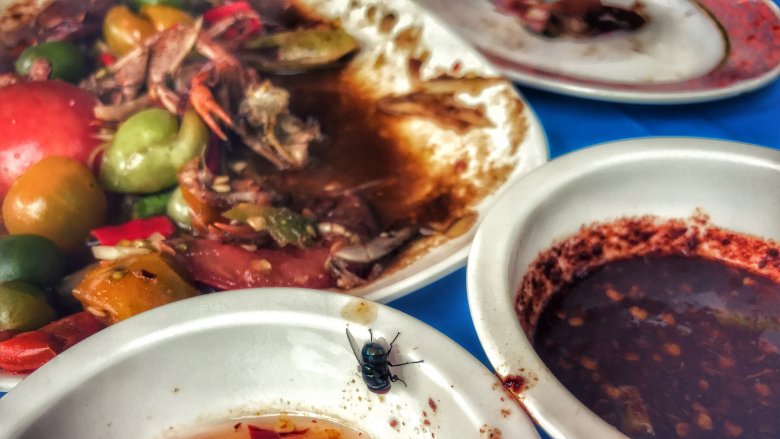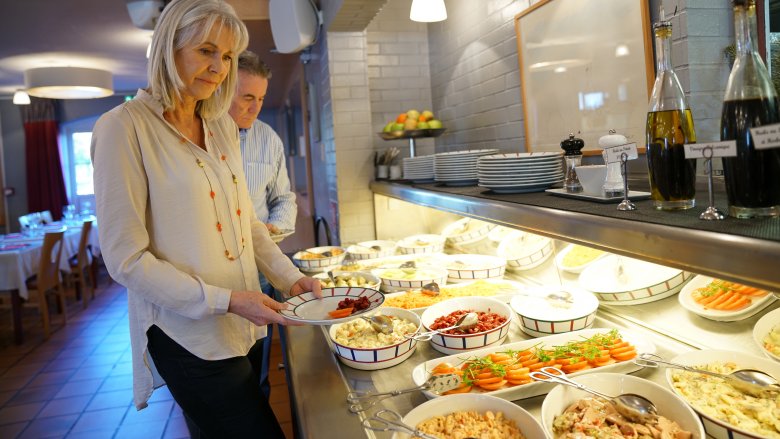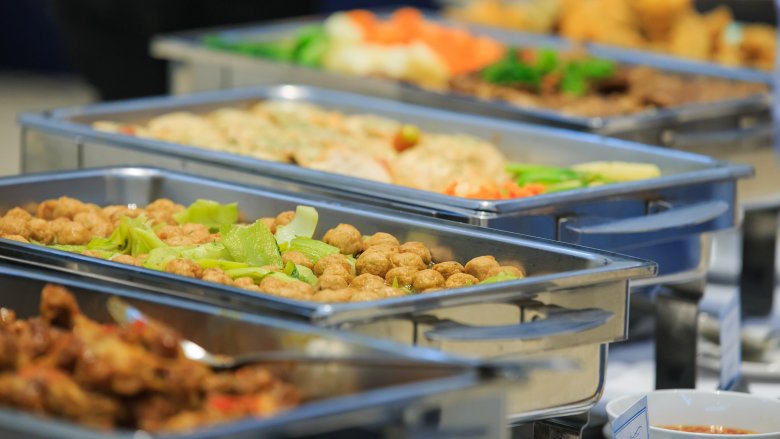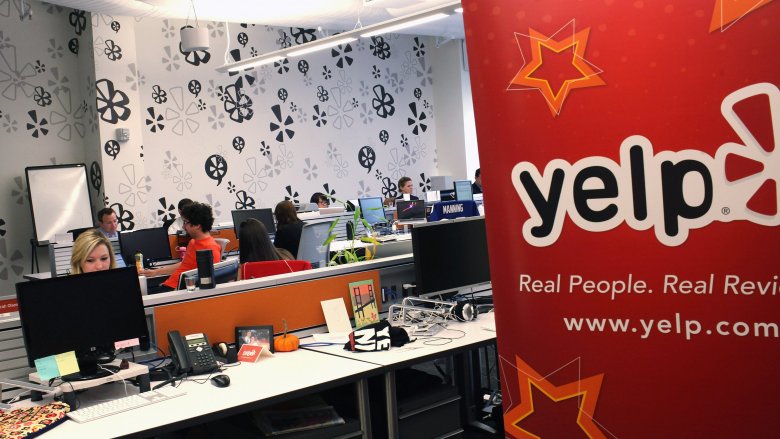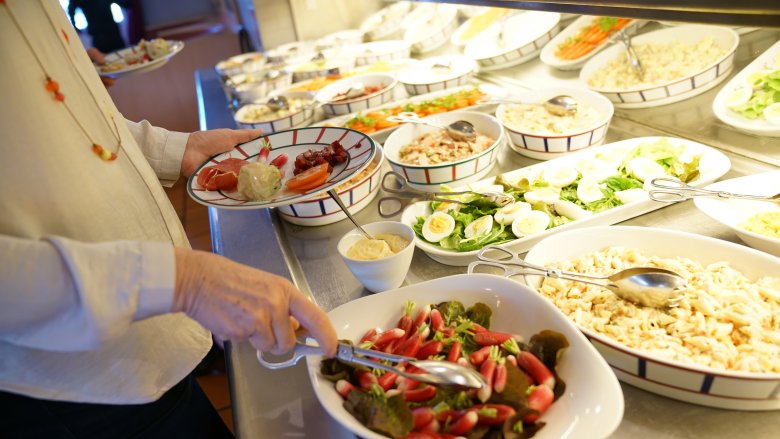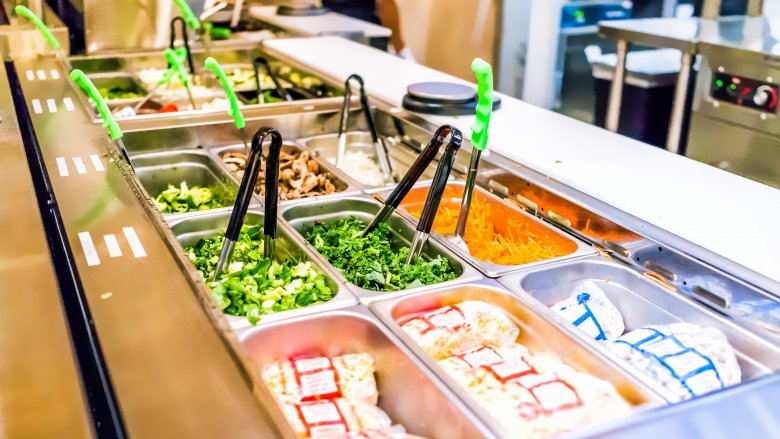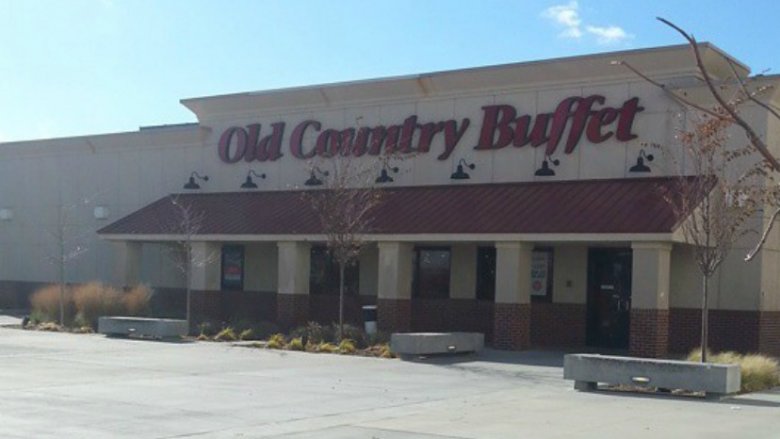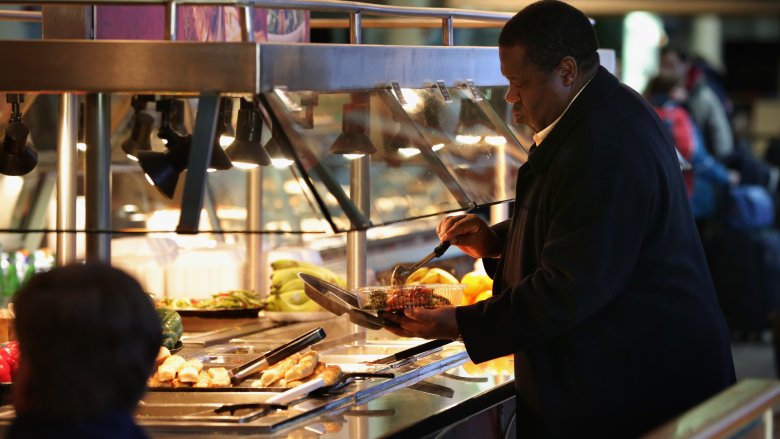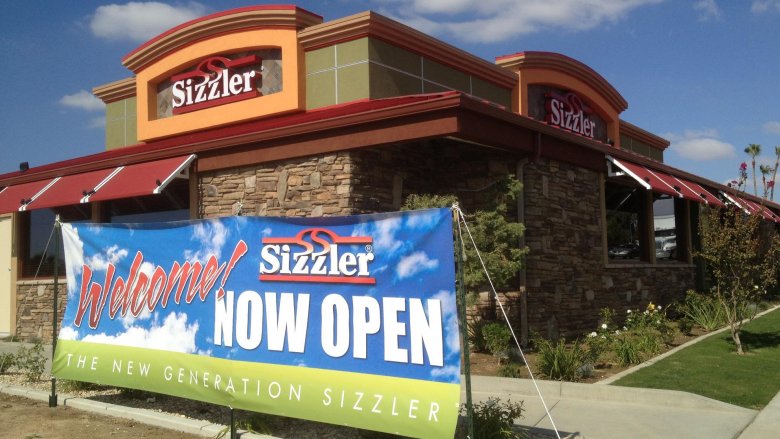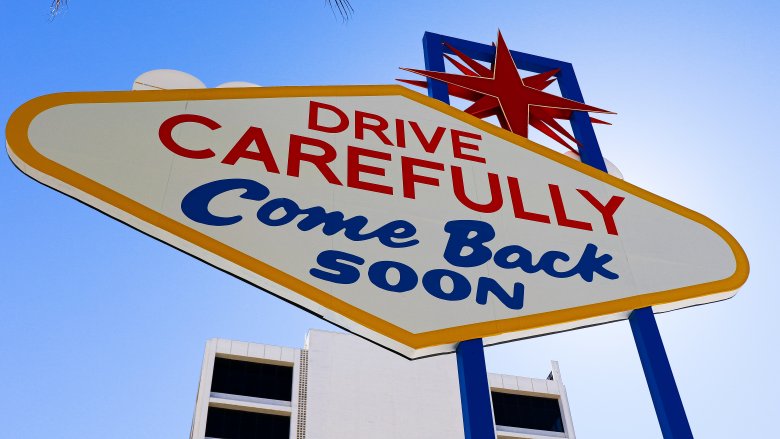The Real Reason Buffet-Style Dining Is Disappearing
Can you remember visiting a buffet when you were young? It represented a vast stretch of freedom to load up your plate with whatever you wanted. When you're an adult, though, you start asking questions. Are you eating your money's worth? Did that kid really just stick his fingers in the mashed potatoes? Why is everything so sticky?
There's a good chance it's been a while since you've been to a buffet, and suspiciously sticky utensils aren't the only reason. So many people are skipping buffets that this sector of the industry is declining — more than you might think.
After Buffets, Inc (who owns chains like Old Country Buffet, Home Town Buffet, and Ryan's) filed for bankruptcy in 2012, they closed 16 percent of their restaurants, according to Forbes. It gets worse. Go back farther and you'll find they've closed a lot of doors since 2000, and according to Nation's Restaurant News, they've seen a decline of 78 percent across all their brands. That's one of the worst declines in the entire industry, but they're not alone. We've said goodbye to Sizzler's buffets, and all-you-can-eat options like Ponderosa, Bonanza, and Big Boy are on the decline, so what's going on here?
They aren't Instagram-friendly
Instagram is a huge deal, and if you're not on it or following it, it's easy to underestimate just how important it is to the food world. Top hashtags include ones like #foodie, #ilovefood, and #foodporn, and it's filled with the beautiful, the delicious, the decadent, and the super-healthy. That said, you can probably guess what the problem is.
Buffets — and other chain restaurants, says The Next Web — just aren't as Instagram-friendly as the little independent cafe that's making their menu based on what they found at the farmers' market that day. Bon Appetit says no one should underestimate the influence Instagram's heavy hitters have: the biggest accounts have hundreds of thousands of followers and can drive enough traffic to a restaurant that they'll not just keep their doors open, but they'll be a massive success.
Do you know where these people aren't going for their foodie photos? The all-you-can-eat buffet. Let's face it — food prepared in bulk quantities and served in large metal warming trays are not usually photogenic.
We know how gross they can be
If you've ever wondered about how sanitary buffets are, you're definitely not alone.Are you wondering whether or not you should worry about it? The answer is, you probably should, and knowing that isn't going to improve business for buffets.
Food Safety News says that even if buffets follow all food safety regulations, there's still a huge problem: serving utensils. You're using the same tongs and forks to pile food on your plate as everyone else, and who knows who's coming down with (or getting over) a cold or the flu. Regulations only require serving utensils to be swapped out every four hours, and that's a lot of bacteria. Couple that with Tonic's report that only about 66 percent of Americans wash their hands the right way after using the restroom, and sharing that serving spoon looks even less appealing.
Let's put it this way. Johns Hopkins infectious disease expert Allison Agwu says (via Tonic), "Buffets can be a cesspool for bacteria and viruses." Is it any wonder people are going elsewhere?
The new generation is eating differently
Millennials are going to be running the world one day, and when it comes to the food industry, they're already pushing some major changes. In 2018, Business Insider reported that their impact was about to become even greater, as they pass the baby boomer generation in terms of pure spending power.
That means the food industry is going to have to change with them — they're not looking for the same kind of food experiences their parents and grandparents enjoy. They're not impressed with the casual dining restaurants (like Applebee's and Chili's) or the buffets — instead, they're opting for fast-casual restaurants (like Chipotle), and ordering delivery or take-out.
Those types of restaurants are about as far from buffets as you can get, and that's causing a big problem for business that bank on all-you-can-eat enthusiasts. Millennials, as a group, just aren't into that sort of thing.
They have an aging target audience
Millennials might be changing the nation's eating habits, but what about the section of the market that buffets are still targeting: the seniors?
When Ovation Brands started closing buffets across the country as a part of their bankruptcy restructuring, Bob Goldin of the consultancy firm Technomic Inc. told the Star Tribune that part of the problem with buffet section of the industry was that "it over-appeals to older customers." There's a lot for them to love about the self-service style of a buffet, but according to QSR, there's been a massive shift in what the older generation is looking for in a restaurant, too.
They say today's seniors are much more health-conscious than previous generations, and that they're well aware of just how much of an impact a reduced-sugar, low-sodium, low-fat diet can have on their health and longevity. It's such a big shift that experts say it'll continue as the nation's population gets increasingly older, and that means they're going to get farther and farther away from buffets and their gluttonous image.
Gluttony isn't cool any more
In the 21st century, people are becoming more aware of what it is they're eating. Healthy eating is getting more and more popular — even fast food chains are creating healthier options. That's a problem for buffets.
Buffets were built on a simple idea: you pay a set price, then gorge yourself until you can't move... then you wait a few minutes, and go back for one last plate. And dessert. Sure, there's always going to be people that want to do that, but an increasing majority of people are watching their calories and their waistlines, and buffets just aren't a good place to do that.
Even Harvard Health says buffets can be a health-conscious diner's worst nightmare, and it's not just the type of food. It's the tendency to overeat, the difficulty in judging portion sizes, and the lack of posted nutritional information. Gluttony just isn't as awesome as it used to be.
They're not ultra-fresh, or customizable
When you go out to eat with your friends and family, which do you prefer: a meal that's been cooked-to-order and is exactly how you requested, or something that was cooked hours ago and transferred to a dish to keep warm?
When Ovation Brands started closing numerous locations across their buffet chains in 2016, the StarTribune talked to Bob Goldin of the restaurant consultancy firm Technomic Inc. He said one of the biggest problems facing buffets is that their very layout and service style made it impossible to incorporate one of the nation's biggest dining demands: fresh-cooked food that's made to order.
That's a deal-breaker for many people, and it a completely understandable one. According to The Hartman Group (via Forbes), a large percentage of diners consider "fresh" to be the "most valued quality distinction marker," and that section of the market is only going to increase. Bord Bia found (via Agriland) that around half of diners make adjustments to dishes that are on the menu, and at a buffet, what you see is what you get.
Yelp and social media reviews are seriously hurting them
According to ReviewTrackers, 6 in 10 people head to the internet to look at product and place reviews before investing, and a whopping 94 percent of those people say that negative reviews online have steered them away from a business. According to Yelp, about 68 percent of their reviews are 5- or 4-stars, while only about 23 percent are 2- or 1-star. That means those low reviews stand out — a lot — and what does that mean for buffets?
Do a quick search, and you'll find there's an almost overwhelming number of buffets rated and reviewed... and most are in that 23 percent. Some — like the Old Country Buffet in Buffalo — weren't just given 1-star reviews, but only got a star because the review said there was no choice to give them a negative. It's a trend that continues. HomeTown Buffet, Corona, California? Two stars. Golden Corral in Freehold, New Jersey? Two stars. Ryan's in Union City, Tennessee? One and a half stars. The list goes on and on, and considering that most come with photos of the unappetizing food, is it any wonder people are being dissuaded from these places?
Buffet dishes are no longer relevant
It doesn't matter how long it's been since you've been to an Old Country Buffet, you can still picture the buffet line. It would be filled with things like mashed potatoes, a few veggie mixes, probably some baked potatoes, and slabs of the cheapest cuts of meat available. Sounds... delicious?
And that's another reason buffets are failing. The kind of comfort food many specialize in is on the way out, and today, people are looking for something a little more special when they go out to eat. They want locally sourced dishes, regional specialties, and something seasonal they're not going to get any other time of the year. That's tough for buffets to do, especially considering most build their menus around what is cheap and what can be cooked in advance, in bulk. According to Eater, modern diners' desire for something sustainable, local, and special is pretty much the exact opposite of what most buffets can offer, and that's hurting them immensely.
Customers want to be served
The restaurant business is always changing, and so are people's attitudes about how food gets to their table — specifically, the don't want to do it themselves. Customer feedback research group Maru/Edr took a look at what impact that's having on what customers see as their ideal restaurant experience, and they say there's an almost overwhelming percentage of people who are looking for wait staff who can act as "food sommeliers".
While 86 percent of the people they surveyed said staff is one of the most important parts of the dining experience, 92.8 percent say they expect staff to be knowledgeable about every aspect of what's on the plate. Diners want to know not just what's in each dish, but how it's prepared and how it's sourced. With no real staff present in buffets, that's an experience diners absolutely aren't going to get. Many diners aren't just content to pile mystery dishes on their plates and chow down, they'll go elsewhere for the experience and knowledge they want.
Making money is hard
In order to make money, buffets need to subscribe to a pretty restrictive business plan. It's a very delicate balance, from start to finish. Price your buffet too high, for example, and people won't come. Too low, and they won't come, either, because they'll be suspicious about the quality of food they're getting.
There are a ton of things buffets need to consider when it comes to everyday operations, and that limits what they can do. In order to turn a profit, they need to rely on dishes that are filling but full of cheap ingredients. It's called the "fill the customer's belly cheaply" metric, and it's definitely a thing. But it can be restrictive, too, and buffets have so many money-making rules they need to follow that it's tough for them to break the mold, do something new, and lure in new customers without devastating their bottom line. That makes them stagnant and boring, and no one wants to pick a restaurant like that for a fun evening out. Would you?
There's a huge amount of waste
Dinnertime staples like Old Country Buffet aren't the only buffets reevaluating things, and hotel breakfast buffets are also taking a good, long look at not just how profitable they are, but how wasteful they are. It's worse than you might think, and according to Forbes, a typical breakfast buffet throws away around half the food that's put out.
That's an unthinkable amount of waste, and the problem really only came to light in 2017. That's when the Hyatt Regency Orlando's executive chef Lawrence Eells opened their kitchen to a team of researchers that looked at just how efficient their buffets were, and the answer was pretty much, "Not efficient at all." Furthermore, The New York Times said they also found that only about 10 to 15 perfect of buffet leftovers were re-purposed, and the rest was just thrown away.
Eells — who oversaw around 5,000 buffet-centric events each year — said he was shocked by the findings, and that "The scope of the problem was an eye-opener beyond belief." All that wasted food isn't just contributing to America's staggering food waste problem, it's money down the drain for buffets that are already struggling.
Old Country Buffet's problems left a big hole in the industry
In 2006, Buffets, Inc merged with Ryan's, creating a powerhouse of all-you-can-eat chain restaurants including HomeTown Buffet, Country Buffet, Old Country Buffet and Ryan's. They ruled the buffet scene for a long time, but the 21st century hasn't been kind. When the Star Tribune reported on the sudden shuttering of a number of locations in 2016 following a bankruptcy filing, they added that since 2008, more than 400 locations had closed.
Just what happened to bring down the company wasn't clearly stated, but a big part of it was a case that started in 2010. That's when a Nebraska man ate there, and left with a case of food poisoning that was nearly deadly. They sued in 2014, and bizarrely, Food Safety News says that when parent company Ovation didn't bother to show up to court, the judge awarded the couple $11.37 million. Part of the reason for that may have been that Ovations (also known as Buffets LLC) purchased the company between the time the lawsuit was filed and when the judge made a ruling. Peter Donbavand, a spokesperson for the company, blames that lack of disclosure — as well as sales that fell short of the seller's projections — for the bankruptcy filing, according to Reuters. The closings that followed left a massive hole in the buffet-style dining industry, which might be a big reason it's hard to find a good buffet these days.
They're restructuring around insane debt
Buffets from the cheap ones in Vegas to Sizzler and Ponderosa are all hurting, but hardest hit has been Ovation Brands/Buffets Inc. They put all their eggs in one basket, so to speak, and when they struggled, that led to closing hundreds of restaurants. Behind the closure of HomeTown Buffet, Ryan's, Old Country Buffet, and Country Buffet was a huge amount of debt.
Like... an almost unthinkable amount of debt.
The parent company had the dubious honor of declaring bankruptcy for an unprecedented third time in 2016 (via CNBC), and they had previously filed Chapter 11 in 2008 and 2012. Let's start with 2008: just two years prior, they had made purchases that made them the largest buffet chain in the US. When they filed for bankruptcy, they wrote off 626 locations and more than $700 million in debt. In 2012, they dumped 494 locations and $245 million in debt (via Business Wire). And in 2016, another 300+ locations were impacted, and the company had more than $100 million in liabilities. That adds up to 1,420 locations and over $1 billion in debt ($1,045,000,000, to be more precise). Those are mind-numbing numbers.
Sizzler's blamed their troubles on buffets
More than one chain of buffets has struggled lately. Remember Sizzler? Their woes go back to at least 1996, when The New York Times reported they closed 136 locations, let 4,600 employees go, and filed for bankruptcy.
Part of their problem was their buffet. It seemed like a great idea to give their target customers — middle-class Americans — the variety they wanted, but it didn't work. Sizzler tried to partner buffets with steak, and when presented with either a nice (but pricey) steak or a wide expanse of buffet food, too many customers were opting for the lower-priced buffet. Even though Sizzler wanted to be a respectable steakhouse, so many people were going there for the buffet that it's what they became known for. Anyone actually wanting steak would head somewhere else.
Buffets also take up a lot of space, and according to restaurant consultant Ron Paul, the average Sizzler was around 10,000 square feet too small for buffet tables. That took away from the number of people they could seat at once, and all that combined to mean the chain was headed for disaster. Looking at bankruptcy, they decided to rebrand. They eventually staged a comeback — but they did it without a buffet.
Even the cheap Vegas buffets are disappearing
There was a time the $1.99 All-You-Can-Eat Buffet was as much a part of the Vegas landscape as any casino. Those super-cheap buffets are gone now, and it's not just a matter of rising food prices.
They were never meant to make a profit, they were meant to get people in the door — people who would then go on to gamble at the adjoining casinos. According to Time, there are a few reasons why this scheme's largely disappeared.
You can blame foodies for a big part of it. People are more demanding than ever as to what's on their plates, and they're willing to pay more for top quality — and these buffets weren't. The other part of it is that casinos and gambling are more widely available than they used to be. That means more people are heading to Vegas for the shows and shopping, instead of gambling. Casinos aren't making the money needed to make up for cheap buffets, so buffets got an overhaul... for better or worse.

